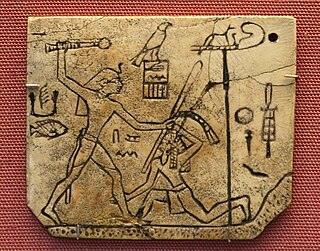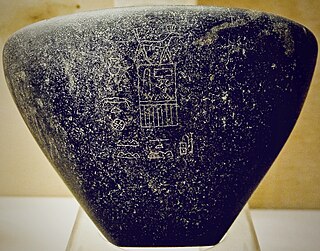Related Research Articles

Narmer was an ancient Egyptian king of the Early Dynastic Period, whose reign began at a date estimated to fall in the range 3173–2987 BC. He was the successor to the Protodynastic king Ka. Many scholars consider him the unifier of Egypt and founder of the First Dynasty, and in turn the first king of a unified Egypt. He also had a prominently noticeable presence in Canaan, compared to his predecessors and successors. Neithhotep is thought to be his queen consort or his daughter.

Khasekhemwy was the last Pharaoh of the Second Dynasty of Egypt. Little is known about him, other than that he led several significant military campaigns and built the mudbrick fort known as Shunet El Zebib.
Qa'a was the last king of the First Dynasty of Egypt. He reigned for 33 years at the end of the 30th century BC.

Merenre Nemtyemsaf was an Ancient Egyptian king, fourth king of the Sixth Dynasty. He ruled Egypt for around 5 years in the early 23rd century BC, toward the end of the Old Kingdom period. He was the son of his predecessor Pepi I Meryre and queen Ankhesenpepi I and was in turn succeeded by Pepi II Neferkare who might have been his son or less probably his brother. Pepi I may have shared power with Merenre in a co-regency at the very end of the former's reign.

The Sixth Dynasty of ancient Egypt, along with the Third, Fourth and Fifth Dynasty, constitutes the Old Kingdom of Dynastic Egypt.

Hor-Aha is considered the second pharaoh of the First Dynasty of Egypt by some Egyptologists, while others consider him the first one and corresponding to Menes. He lived around the 31st century BC and is thought to have had a long reign.

Den, also known as Hor-Den, Dewen, and Udimu, was the Horus name of a pharaoh of the Early Dynastic Period who ruled during the First Dynasty of Egypt. He is the best archaeologically-attested ruler of this period, credited with bringing prosperity to his realm.

Sehertawy Intef I was a local nomarch at Thebes during the early First Intermediate Period and the first member of the 11th Dynasty to lay claim to a Horus name. Intef reigned from 4 to 16 years c. 2120 BC or c. 2070 BC during which time he probably waged war with his northern neighbor, the Coptite nomarch Tjauti. Intef was buried in a saff tomb at El-Tarif, known today as Saff el-Dawaba.
Intef III was the third pharaoh of the Eleventh Dynasty of Egypt during the late First Intermediate Period in the 21st century BC, at a time when Egypt was divided in two kingdoms. The son of his predecessor Intef II and father of his successor Mentuhotep II, Intef III reigned for 8 years over Upper Egypt and extended his domain North against the 10th Dynasty state, perhaps as far north as the 17th nome. He undertook some building activity on Elephantine. Intef III is buried in a large saff tomb at El-Tarif known as Saff el-Barqa.

Amenemhat I, also known as Amenemhet I, was a pharaoh of ancient Egypt and the first king of the Twelfth Dynasty of the Middle Kingdom.

Senusret II or Sesostris II was the fourth pharaoh of the Twelfth Dynasty of Egypt. He ruled from 1897 BC to 1878 BC. His pyramid was constructed at El-Lahun. Senusret II took a great deal of interest in the Faiyum oasis region and began work on an extensive irrigation system from Bahr Yussef through to Lake Moeris through the construction of a dike at El-Lahun and the addition of a network of drainage canals. The purpose of his project was to increase the amount of cultivable land in that area. The importance of this project is emphasized by Senusret II's decision to move the royal necropolis from Dahshur to El-Lahun where he built his pyramid. This location would remain the political capital for the 12th and 13th Dynasties of Egypt. Senusret II was known by his prenomen Khakheperre, which means "The Ka of Re comes into being". The king also established the first known workers' quarter in the nearby town of Senusrethotep (Kahun).

Umm El Qaʻāb is an archaeological site located at Abydos, Egypt. Its modern name, meaning "Mother of Pots", refers to the mound made of millions of broken pieces of pots which defines the landscape. Umm el Qa'ab contains evidence that the site is the cemetery for Egypt's predynastic proto-kings along with rulers of the 1st and 2nd dynasties. In addition to early royal tombs, evidence also suggests a link between the site, the cult of Osiris, and Osiris' annual festival.

Merneith was a consort and a regent of Ancient Egypt during the First Dynasty. She may have been a ruler of Egypt in her own right, based on several official records. If this was the case and the earlier royal wife Neithhotep never ruled as an independent regent, Merneith may have been the first female pharaoh and the earliest queen regnant in recorded history. Her rule occurred around 2950 BC for an undetermined period. Merneith’s name means "Beloved by Neith" and her stele contains symbols of that ancient Egyptian deity. She may have been Djer's daughter and was probably Djet's senior royal wife. The former meant that she would have been the great-granddaughter of unified Egypt's first pharaoh, Narmer. She was also the mother of Den, her successor.

Iry-Hor was a predynastic pharaoh of Upper Egypt during the 32nd century BC. Excavations at Abydos in the 1980s and 1990s and the discovery in 2012 of an inscription of Iry-Hor in Sinai confirmed his existence. Iry-Hor is the earliest ruler of Egypt known by name and is sometimes cited as the earliest-living historical person known by name.

Seth-Peribsen is the serekh name of an early Egyptian monarch (pharaoh), who ruled during the Second Dynasty of Egypt. His chronological position within this dynasty is unknown and it is disputed who ruled both before and after him. The duration of his reign is also unknown.

Anedjib, more correctly Adjib and also known as Hor-Anedjib, Hor-Adjib and Enezib, is the Horus name of an early Egyptian king who ruled during the 1st Dynasty.

Nubkheperre Intef was an Egyptian king of the Seventeenth Dynasty of Egypt at Thebes during the Second Intermediate Period, when Egypt was divided by rival dynasties including the Hyksos in Lower Egypt.

Sekhemre-Wepmaat Intef-Aa was an Ancient Egyptian pharaoh of the 17th Dynasty of Egypt, who lived late during the Second Intermediate Period, when Egypt was divided in two by Hyksos-controlled Lower Egypt and Theban-ruled Upper Egypt.

Ka, also (alternatively) Sekhen, was a Predynastic pharaoh of Upper Egypt belonging to Dynasty 0. He probably reigned during the first half of the 32nd century BC. The length of his reign is unknown.
Taurus, or Bull is the provisional name for a predynastic ruler, the existence of whom is highly controversial. He is considered a ruler of the late Chalcolithic Naqada III culture of southern Egypt.
References
- ↑ Kühn, Thomas (2001). "The Origin of Egyptian Writing in the Predynastic Period". Kemet (4/2001): 32–33. ISSN 0943-5972.
- ↑ Höveler-Müller, Michael (2008). "On the early kings 'Finger Snail' and 'Fish' from the tomb U-j in Umm el-Qaab". Studies on Ancient Egyptian Culture (37). Hamburg: Buske: 159–167.
- ↑ Schlögl, Hermann A. (2008). Das alte Ägypten. Munich: Beck. p. 59. ISBN 978-3-406-48005-8.
- ↑ Kahl, Jochem (2006). "Inscriptional Evidence for the Relative Chronology of Dyns. 0–2". In Hornung, Erik; Krauss, Rolf; Warburton, David A. (eds.). Ancient Egyptian Chronology. Leiden and Boston: Brill. p. 96. ISBN 9789004113855.
- ↑ Schraten, Jürgen (11 November 2010). Zur Aktualität von Jan Assmann: Einleitung in sein Werk. Springer. p. 59. ISBN 9783531926735.
- ↑ Altenmüller, Hartwig; Kloth, Nicole (2008). Studien zur Altägyptischen Kultur. Vol. 37. Helmut Buske. ISBN 9783875489378.
- ↑ Pirzer, Margret; Pirzer, J. H. "Skorpion L". Nefershapiland. Retrieved 27 March 2021.